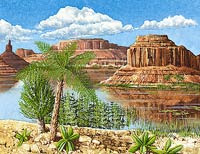1. Unit materials: Part I: Research the Devonian Period. Part II: Learn earth's time periods: a) project note sheet: Periods of the Earth, b) Divisions of Geologic Time chart. Part III: Transition to evolution: student note sheet: Cladogram of Creatures.
2. Visit BrainPop and have Tim & Moby introduce you to geologic time. Login with the Username: riversidevs and Password: rvs.
3. Here is a Timeline of Eras with brief summaries.
4. Visit Eagle Library research for research information and materials.
3. Here is a Timeline of Eras with brief summaries.
4. Visit Eagle Library research for research information and materials.

Hello 7th graders!
You are here to research the natural history of the Earth by learning about the divisions of geologic time. The basic divisions of geologic time include eons, eras, periods, and epochs. Here is a "Brief History of Life" on earth. But, let's begin our Web search with the chart on this Web site: http://www.enchantedlearning.com/subjects/Geologictime.html.
Use the following Web sites to research these three eras: Cenozoic:
c. http://www.palaeos.com/Paleozoic/Paleozoic.htm
Use the following Web sites to research these five periods.
Quaternary:
http://www.fossils-facts-and-finds.com/quaternary_period.html
Tertiary:
http://www.fossils-facts-and-finds.com/tertiary_period.html
Cretaceous:
a. http://www.fossils-facts-and-finds.com/cretaceous_period.html
Use the following Web sites to research these five periods.
Quaternary:
http://www.fossils-facts-and-finds.com/quaternary_period.html
Tertiary:
http://www.fossils-facts-and-finds.com/tertiary_period.html
Cretaceous:
a. http://www.fossils-facts-and-finds.com/cretaceous_period.html
b. http://www.palaeos.com/Mesozoic/Cretaceous/Cretaceous.htm
Jurassic:
a. http://www.fossils-facts-and-finds.com/jurassic_period.html
Jurassic:
a. http://www.fossils-facts-and-finds.com/jurassic_period.html
Devonian: http://www.scotese.com/newpage3.htm
a. The Age of Fishes
b. Silurian and Devonian
c. Late Devonian to Permian
Cambrian:
a. http://www.fossils-facts-and-finds.com/cambrian_period.html
a. The Age of Fishes
b. Silurian and Devonian
c. Late Devonian to Permian
Cambrian:
a. http://www.fossils-facts-and-finds.com/cambrian_period.html
b. http://www.ucmp.berkeley.edu/cambrian/camb.html
Let's transition from time periods to evolution:
Elephants
A. Locate four elephant ancestors from four different time periods:
Elephant evolution
Elephant evolution tree (cladogram)
B. If you need help, just click the links below:
Palaeomastodon, Moeritherium
Gomphotherium, Stegodons,
Mastodon, Mammoth
Modern elephant: Use the notes from your research packet.
Let's transition from time periods to evolution:
Elephants
A. Locate four elephant ancestors from four different time periods:
Elephant evolution
Elephant evolution tree (cladogram)
B. If you need help, just click the links below:
Palaeomastodon, Moeritherium
Gomphotherium, Stegodons,
Mastodon, Mammoth
Modern elephant: Use the notes from your research packet.
Standards for 7th grade life science from <clrn.org>:
4c. Students know that the rock cycle includes the formation of new sediment and rocks and that rocks are often found in layers, with the oldest generally on the bottom.
4g. Students know how to explain significant developments and extinctions of plant and animal life on the geologic time scale.
Standards for information literacy from <csla.net>:
Standards for information literacy from <csla.net>:
1. The student who is information literate accesses information efficiently and effectively.
1.7 Uses digital resources to access information
2. The student who is information literate evaluates information critically and competently.
2.3 Selects relevant information during the research process.
3. The student who is information literate uses information accurately and competently.
3.3 Communicates and synthesizes ideas in logical and creative or novel ways.
8. The student who contributes positively to the learning community and to society is information literate and practices ethical behavior in regard to information and information technology.
8.2 Understands the reasons and methods for citing sources.



No comments:
Post a Comment